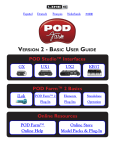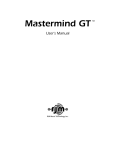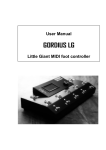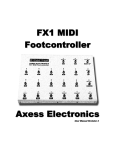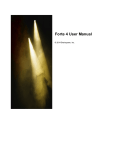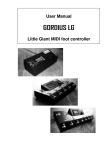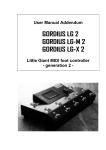Download M-Audio Trigger Finger Pro User guide
Transcript
User Guide Manual Version 1.0 Table of Contents (Click a chapter's name to skip to it.) Introduction............................................ 3 Browsers ............................................... 21 Support ............................................. 3 Tag Browsers .................................. 22 Getting Started ................................. 4 About Setlists......................... 24 DAW Mode ................................... 4 Patch Browser ................................ 25 Standalone Mode ......................... 6 Important Note ............................. 8 Graphical Interface .............................. 27 Assignable Controls ....................... 28 Overview................................................. 9 Controls and Parameters ............ 28 Control Modes ............................ 29 Menu Bar .............................................. 11 Plugin Edit Mode ................... 29 Save ................................................. 12 Patch Edit Mode .................... 29 Open ................................................ 13 Learn Mode ............................ 30 Settings ........................................... 14 Pads ................................................. 31 About ............................................... 18 Master Controls .............................. 32 Tag Mode ........................................ 18 Trademarks and Licenses ................... 33 View ................................................. 18 Quick Patch Changer..................... 19 Tempo ............................................. 19 MIDI LED ......................................... 20 Arsenal Logo .................................. 20 2 Introduction Arsenal is an intelligent production hub and advanced content library designed for your Trigger Finger Pro. Use the intelligent content filter parameters to find the sound you need, quickly. Arsenal integrates directly into popular digital audio workstations (DAWs), but can also be run in standalone mode. The latter lets you utilize VST instruments without firing up your DAW and is ideal for software- based stage performance. Finally, Arsenal's interface lets you map the hardware controls visually, making customization and workflow a breeze. Support For the latest information about this product (system requirements, compatibility information, etc.) and product registration, visit m-audio.com/TFP. For additional product support, visit m-audio.com/support. 3 Getting Started DAW Mode To use Arsenal with Trigger Finger Pro in your digital audio workstation (DAW), follow the instructions below to (1) set Trigger Finger Pro to control your DAW and Arsenal, (2) set up Arsenal in your DAW, and then (3) load your plugins in Arsenal and select a patch. To select Trigger Finger Pro to control your DAW and Arsenal: 1. Connect Trigger Finger Pro to your computer using a standard USB cable. (If you are connecting Trigger Finger Pro to a USB hub, make sure it is a powered hub.) 2. Power-on Trigger Finger Pro. 3. Open your DAW. 4. Open your DAW's Preferences (or Options, Device Setup, etc.), and select Trigger Finger Pro as your controller. Make sure that MIDI Port 1 is enabled for standard MIDI, MIDI Port 2 is enabled for Mackie Control or HUI communication, and MIDI Port 3 is disabled or not shown (Trigger Finger Pro uses this port to communicate with Arsenal). 5. Turn Trigger Finger Pro's Value Dial to browse through its available presets, and then push it to select one that corresponds to your DAW and whose name includes Arsenal. (These are Trigger Finger Pro presets and are not related to the patches in Arsenal.) Your Trigger Finger Pro can now communicate with your DAW and Arsenal. To set up Arsenal in your DAW: 1. Open your DAW and make sure Trigger Finger Pro is selected as a controller for your DAW (described above). 2. Create a MIDI track in your DAW, and load Arsenal onto that track as you would with a typical plugin, and select that track. Important: You may need to open your DAW's Preferences (or Options, Device Setup, etc.) and select the directory where Arsenal was installed before it appears in your DAW's list of available plugins. 4 To select an instrument plugin and patch in Arsenal: 1. Set up Arsenal in your DAW (described above). 2. In the Plugin Tag Browser, click the desired plugin to select it. 3. In the Patch Browser on the right side of the window, click one of the available patches to load it. Important: AIR Drums and Hybrid 3.0 will be automatically available and have several patches you can select. To add other instrument plugins to Arsenal, see the following section. To load additional instrument plugins in Arsenal: 1. Click the Settings icon (the gear) to open the Settings Window. 2. Click a Plugin Folder field, and select where the desired plugin is located on your hard drive. 3. Click Scan. You can now use any supported plugins in that location with Arsenal (after they are validated in the Plugin Manager above). Note: You can scan up to two locations at once, but you can keep selecting new locations and scanning, which will keep adding plugins to the Plugin Manager. In other words, scanning is a cumulative process. To scan while overwriting the entire Plugin Manager, press and hold your keyboard's Control (Windows) or Command (Mac OS X) button, and then click Scan. 4. Click OK to close the Settings Window (and to import any new plugins or presets that have been added to the Plugin Manager). For more information about adding plugins to Arsenal, see the Menu Bar: Settings chapter. 5 Standalone Mode To use Arsenal with Trigger Finger Pro in Standalone Mode (i.e., without a digital audio workstation [DAW]), follow the instructions below to (1) set Trigger Finger Pro to control Arsenal and then (2) load your plugins into Arsenal and select a patch. To set up Arsenal in Standalone Mode (without a DAW): 1. Connect Trigger Finger Pro to your computer using a standard USB cable. (If you are connecting Trigger Finger Pro to a USB hub, make sure it is a powered hub.) 2. Power-on Trigger Finger Pro. 3. Turn Trigger Finger Pro's Value Dial to browse through its available presets, and then push it to select one whose name includes Arsenal. (These are Trigger Finger Pro presets and are not related to the patches in Arsenal.) Your Trigger Finger Pro can now communicate with Arsenal. 4. Open Arsenal. If you created a desktop shortcut, double-click it. Otherwise, double-click the application where you installed it. These are the default locations: Windows: Program Files\VstPlugins\ Mac OS X: Applications/M-Audio/Arsenal 5. In Arsenal, click the Setting icon (the gear) to open the Settings window. 6. Click the I/O Settings button to open the Audio/MIDI Settings window. 7. Under Active MIDI Inputs, make sure the option labeled Trigger Finger Pro MIDI is checked. Click the circle next to the option to check or uncheck it. 8. Close the Audio/MIDI Settings window and Settings window. 9. In the Plugin Tag Browser, click the desired plugin to select it. 10. In the Patch Browser on the right side of the window, click one of the available patches to load it. Important: AIR Drums and Hybrid 3.0 will be automatically available and have several patches you can select. To add other instrument plugins to Arsenal, see the following section. 6 To load additional instrument plugins in Arsenal: 1. Click the Settings icon (the gear) to open the Settings Window. 2. Click a Plugin Folder field, and select where the desired plugin is located on your hard drive. 3. Click Scan. You can now use any supported plugins in that location with Arsenal (after they are validated in the Plugin Manager above). Note: You can scan up to two locations at once, but you can keep selecting new locations and scanning, which will keep adding plugins to the Plugin Manager. In other words, scanning is a cumulative process. To scan while overwriting the entire Plugin Manager, press and hold your keyboard's Control (Windows) or Command (Mac OS X) button, and then click Scan. 4. Click OK to close the Settings Window (and to import any new plugins or presets that have been added to the Plugin Manager). For more information about adding plugins to Arsenal, see the Menu Bar: Settings chapter. 7 Important Note In order for Trigger Finger Pro to affect Arsenal's Assignable Controls and Pads, Trigger Finger Pro's Assignable Knobs, Assignable Faders, Assignable Buttons, and pads must their Mapping set to Arsenal. This is done automatically when you select a preset on Trigger Finger Pro whose name includes Arsenal. If, however, you change the mapping or create a new preset that you want to control Arsenal, remember to do the following: To set Trigger Finger Pro to control Arsenal: 1. Press Trigger Finger Pro's Control Mode (Ctrl) button. 2. Press the third Function Button (Mapping). 3. Use the Value Dial to select the control type (Knobs, Faders, or Buttons). 4. Press the second Function Button (Toggle All) until all banks on the left of the display list Arsenal. Alternatively, use the Assignable Knobs to select the mapping, if you want to allow only certain banks to control Arsenal. 5. Repeat Steps 3-4 for the other controls on Trigger Finger Pro (Knobs, Faders, or Buttons). 6. Press the fourth Function Button (Exit). 7. Press Trigger Finger Pro's Pad Mode (Pad) button. 8. Press the third Function Button (Mapping). 9. Press the second Function Button (Toggle All) until all banks on the left of the display list Arsenal. Alternatively, use the Assignable Knobs to select the mapping, if you want to allow only certain banks to control Arsenal. 10. Press the fourth Function Button (Exit). 8 Overview Menu Bar Browsers Graphical Interface Arsenal's interface is divided into three different parts. • The Menu Bar contains menus that let you configure Arsenal and manage files. Learn more about this in the Menu Bar chapter. • The Browsers contain lists of your plugins' patches. You can select a plugin from the Plugin Tag Browser (first row, second column) and then select a patch from Patch Browser (the right-most pane). You can also filter your patches by different categories. Learn more about this in the Browsers chapter. 9 • The Graphical Interface is a visual representation of the Trigger Finger Pro controls that Arsenal can use (the Assignable Knobs, Assignable Faders, Assignable Buttons, and the pads). When you adjust these controls on your Trigger Finger Pro hardware, the graphical interface will show the adjustment in real time. Learn more about this in the Graphical Interface chapter. 10 Menu Bar 1 2 3 4 5 6 7 8 9 10 This is a list of items in the Menu Bar. Click one to jump to that section of this guide. 1. Save 2. Open 3. Settings 4. About 5. Tag Mode 6. View 7. Quick Patch Changer 8. Tempo 9. MIDI LED 10. Arsenal Logo 11 Save Click the Save icon to select an available option for saving, exporting, or backing up various files: Save Setlist Select this option to save a Setlist for later use. In the window that appears, select the location and enter a name for the file (.set), and then click the Save button. To learn more about how to use Setlists, see Browsers: Tag Browsers: About Setlists. Export Plugin Map Select this option to save a Plugin Map for later use (after first selecting a plugin in the Plugin Tag Browser and a patch from the Patch Browser). In the window that appears, select the location and a name for the file (.vip), and then click the Save button. Note: A Plugin Map consists of the patches, tags, Assignable Control settings, transposition, and layout color for the plugin in Arsenal. When importing a Plugin Map, you can choose to import (A) the patches only, (B) the patches and tags, or (C) the patches, tags, and Assignable Control settings. Check the Replace existing tags box to overwrite any existing tags, or leave it unchecked to merge the old and new tags. Back Up Select this option to save a Database Backup for later use. In the window that appears, select the location and enter a name for the file (.bak), and then click the Save button. Save Sequence from Hardware Select this option to save a Sequence stored on your Trigger Finger Pro hardware onto your hard disk for later use. In the window that appears, select the location and enter a name for the file (.tfpseq), and then click the Save button. Important: You must save your Sequence on the Trigger Finger Pro hardware itself before you can save it in Arsenal. 12 Open Click the Open icon to select an available option for loading, importing, or restoring various files: Load Setlist Select this option to load a previously saved Setlist. In the window that appears, locate and select the desired Setlist file (.set), and then click the Open button. To learn more about how to use Setlists, see Browsers: Tag Browsers: About Setlists. Import Plugin Map Select this option to import a Plugin Map. In the window that appears, locate and select the desired Plugin Map file (.vip), and then click the Open button. Note: A Plugin Map consists of the patches, tags, Assignable Control settings, transposition, and layout color for the plugin in Arsenal. When importing a Plugin Map, you can choose to import (A) the patches only, (B) the patches and tags, or (C) the patches, tags, and Assignable Control settings. Check the Replace existing tags box to overwrite any existing tags, or leave it unchecked to merge the old and new tags. Restore Backup Select this option to restore a previously saved Database Backup. In the window that appears, locate and select the desired Database Backup file (.bak), and then click the Open button. Load Sequence into Hardware Select this option to load a previously saved sequence into your Trigger Finger Pro hardware. In the window that appears, locate and select the desired Sequence (.tfpseq) file, and then click the Open button. Important: You must save your Sequence on the Trigger Finger Pro hardware itself before you can save it in Arsenal. 13 Settings Click the Settings icon to open the Settings Window, which lets you configure Arsenal. Items per Page: This field determines the maximum number of patches shown in each page of the Patch Browser (you can use the left and right arrows [ or ] at the bottom of the Patch Browser to move between the different pages). Click this field to enter another number (up to 40), and then close and reopen the Arsenal window to apply the changes. Higher numbers may take more time to load when moving between the Patch Browser's pages. Auto-Tag Enable: Check this box to allow Arsenal to automatically apply tags to plugins' patches, if available. This will only work for certain supported plugins. 14 I/O Settings: When you are using Arsenal in Standalone Mode, click this button to open the Audio/MIDI Settings window, which lets you configure Arsenal's audio and MIDI settings in the same way you would configure those of your DAW: Important: This window is available in Standalone Mode only. • Audio Device Type: Click this and select the type of device you want to use for audio input and output. • Output: Click this drop-down menu to select the audio hardware driver you want to use to play audio from Arsenal. Click the Test button to play a tone through that driver. • Input: Click this drop-down menu to select the audio hardware driver you want to use to send audio into Arsenal. • Sample Rate: Click this to drop-down menu to select the desired sample rate. Your selection should depend on your audio interface's available sample rates. • Audio Buffer Size: Click this drop-down menu to set the latency of your audio system. Lower values result in a more immediate response but also more CPU consumption, which may result in audible clicks and pops. Higher values are much more CPU-friendly but produce a higher latency, resulting in a delay between hitting a pad and hearing the corresponding sound. The ideal audio buffer size also depends on your computer's CPU performance. Experiment with this to find the best setting for your system. • Active MIDI Inputs: These checkboxes represent the active MIDI inputs on your computer system. (Make sure that MIDI Port 1 is enabled for standard MIDI, MIDI Port 2 is enabled for Mackie Control or HUI communication, and MIDI Port 3 is either disabled or not shown.) • MIDI Output: Click this drop-down menu to define the MIDI out port that Trigger Finger Pro's MIDI messages are routed to (if any). 15 Plugin Manager: This is a list of all available plugins, based on your selected Plugin folders. The columns (described below, left to right) indicate the plugins' status: • Use: Check this box to allow Arsenal access to this plugin. If this box is unchecked, it will not appear in Plugin Tag Browser on Arsenal's main page. • Name: This is the plugin's name. • Manufacturer: This is the plugin's maker. • Type: This is the plugin type. This field will appear for certain supported plugins only. • Input: This is how many MIDI channels can be sent to the plugin. • Output: This is how many MIDI channels the plugin can send out. • Validation: A green circle in this column indicates that the plugin is properly scanned and can be used by Arsenal. An orange triangle with an exclamation point ( ! ) indicates that the plugin was not properly scanned. If you see this, hover the mouse cursor over the icon to see a tooltip that will indicate why the item did not scan. Please note that Arsenal can validate only VST instruments (not effects) that have the same bit depth as your version of Arsenal (click the About [ ? ] icon to check Arsenal's bit depth). A red circle indicates that a plugin has been "blacklisted." If you try to scan an invalid plugin and it fails, you will be asked whether or not you want to blacklist the plugin. To remove the plugin from the blacklist, simply click the red circle, and its status will change to "invalid" (described above). 16 Plugin Folder: Click the field to select where your plugins are stored. Arsenal will scan this location when you click Scan. You can then any supported plugins in that location with Arsenal. You can scan up to two locations. Scan: Click this to prompt Arsenal to scan the Plugin Folder locations. You can then use any supported plugins in that location with Arsenal (after they are validated in the Plugin Manager). You can scan up to two locations at once, but you can keep selecting new locations and scanning, which will keep adding plugins to the Plugin Manager. In other words, scanning is a cumulative process. To scan while overwriting the entire Plugin Manager, press and hold your keyboard's Control (Windows) or Command (Mac OS X) button, and then click Scan. OK: Click this to close the Settings Window (and to import any new plugins or presets that have been added to the Plugin Manager). 17 About Click the About ( ? ) icon to show information about this version of Arsenal. Tag Mode Click the Tag Mode icon to enter or exit Tag Mode. In this mode, you can edit the tags for a patch of your plugin. This is useful for maintaining large lists of plugins, letting you tag and sort them by various attributes (e.g., by Timbres such as Airy, Distorted, or Fat, or by Styles such as Ambient or Dance). See Browsers: Tag Browsers to learn more about tags. View Click the View icon to cycle through the available Views of Arsenal. There are three available views: • Browsers shown, Graphical Interface hidden • Graphical Interface shown, Browsers hidden • Browsers and Graphical Interface shown 18 Quick Patch Changer The Quick Patch Changer lets you move through your currently selected plugin's list of patches without having to use the Browsers. To select the previous or next patch, click the left or right ( or ) arrow, respectively. To open the plugin's editor (its own graphical user interface), double-click the patch name. Tempo The Tempo display shows the current Sequence's tempo, as determined by the tempo of the Sequence currently loaded on your Trigger Finger Pro. Note: If Trigger Finger Pro's Clock is set to External, the value is determined by the tempo of the external source. You can change the tempo by either (A) pressing its Tap Tempo button several times at the desired rate or (B) pressing its Sequence Mode (Seq) button and using the first Assignable Knob to change the value. Note: If Trigger Finger Pro's Clock is set to External, you can change the tempo by adjusting the tempo of the external source. 19 MIDI LED The MIDI LED is a green light next to the Arsenal logo that lights up when Arsenal is receiving MIDI messages. This is useful for troubleshooting, if you believe your Trigger Finger Pro is not communicating properly with Arsenal. Note: If the MIDI LED does not light up when you use Trigger Finger Pro, check the following: • Make sure Trigger Finger Pro is securely connected to your computer. • Trigger Finger Pro's Assignable Knobs, Assignable Faders, Assignable Buttons, and pads must have their Mapping set to Arsenal. To do this, see Getting Started: Important Note. Arsenal Logo The Arsenal logo will glow blue in the active instance of Arsenal when your Trigger Finger Pro is connected to your computer. This is to help you identify which instance of Arsenal is "in focus" (if multiple instances are open). Note: The pads will sound on any track (with an instance of Arsenal) that is record-armed, even if that track contains an inactive instance of Arsenal. 20 Browsers Tag Browsers Patch Browser Arsenal's Browsers let you quickly select and load your plugins' patches. The Browsers are divided into two sections: • Use the six Tag Browsers to select a plugin and to sort and select your patches with different editable tags. You can create, assign, unassign, rename, or delete tags as you wish. See the Tag Browsers chapter below to learn more. • Use the Patch Browser to browse and select patches for the currently selected plugin. You can use the search field to browse your patches. See the Patch Browser chapter below to learn more. 21 Tag Browsers The Tag Browsers contain collections of tags that you can use to sort your patches by sonic characteristics, articulation, instrument, or other attributes. To show a patch with specific tags, click one or more tags in one or more Tag Browsers. The available patches with those attributes will appear in the Patch Browser on the right-hand side. To change a patch's tags: Tip: You can quickly add a tag to a patch by dragging it from the Patch Browser onto the desired tag in a Tag Browser. 1. Select a patch by clicking it in the Patch Browser on the right-hand side. (To select a different plugin, click the desired plugin in the Plugin Tag Browser.) 2. Click the Tag Mode icon in the Menu Bar. The icon will light up when you are in Tag Mode. In the Tag Browsers, the currently selected patch's current tags will appear as selected. Do any of the following: 3. 4. 5. • Associate a tag with a patch by clicking an unselected tag to select it. • Dissociate a tag from a patch by clicking a selected tag to deselect it. • Create and name a new tag by clicking the + symbol above a Tag Browser. Click the Tag Mode icon to exit Tag Mode. 22 To rename a tag, right-click a tag's name and select Rename, or just double-click the tag's name. You can do this whether or not you are in Tag Mode. Any patches associated with that tag will update automatically. To delete a tag, right-click a tag's name and select Remove [tag name]. You can do this whether or not you are in Tag Mode. Any patches associated with that tag will update automatically. To transpose a plugin, right-click a plugin's name in the Plugin Browser and select Transpose. This lets you shift its global pitch up or down by up to 36 semitones. This is useful if you want to offset the pitches that are available to you on Trigger Finger Pro's pads. 23 About Setlists A Setlist is a collection of patches that you can to "group" together for quick access. This is useful, for instance, if you found several patches that sound good together or if you want to have a record of what patches you used in a specific performance. Tip: You can store patches from separate plugins within the same Setlist. To create a Setlist, click the + symbol at the top of the Setlist Browser, and then enter a name for it. To add patches to a Setlist, simply click and drag them from the Patch Browser onto the desired Setlist in the Setlist Browser. To enter or exit a Setlist, simply click it in the Setlist Browser. To save a Setlist, click it to select it in the Setlist Browser, and then click the Save icon and select Save Setlist. In the window that appears, select the location and enter a name for the file (.set), and then click the Save button. To load a Setlist, click the Open icon and select Load Setlist. In the window that appears, locate and select the desired Setlist (.set), and then click the Open button. 24 Patch Browser The Patch Browser contains a list of available patches based on (1) the currently selected plugin in the Plugin Tag Browser and (2) the currently selected tags in the other Tag Browsers. To browse through the patches, use the scroll bar on the right-hand side and the left and right arrows ( or ) at the bottom. (To select a different plugin, click the desired plugin in the Plugin Tag Browser.) Tip: Open the Settings Window and change the Items per Page value to change how many patches appear on each page of the Patch Browser. To load a patch, simply click it. Tip: You can also load a patch directly on your Trigger Finger Pro: 1. Enter Control Mode by pressing the Control Mode (Ctrl) button. 2. Press and hold the first or second Function Button. 3. Turn the Value Dial to browse through the available patches. 4. Press the Value Dial to load a patch. To open the plugin's own graphical user interface, double-click the name of a patch. To mark a patch as a "favorite," click the "thumbs-up" icon on the right-hand side of its name. 25 To search for a patch by keyword, click the Search… field at the top and enter a name. The results will appear in the list below. To clear the results, click the X icon. To sort the patches by name, date, or favorites, click the ≡ icon and select one of the options. To delete a patch, right-click it and select Delete Patch. To manually import patches into this list: 1. Select the desired plugin in the Plugin Tag Browser. 2. Double-click the name of a patch in the Patch Browser to open the plugin's own graphical user interface. 3. In the plugin's graphical user interface, select the patch you want to manually import. 4. Click the Import Patch (arrow-in-circle) icon in the Patch Browser's upper-right corner. The patch will then be added to the list in the Patch Browser. 26 Graphical Interface Assignable Controls Pads Master Controls To provide a familiar environment, Arsenal's Graphical Interface resembles the control layout of your Trigger Finger Pro. It is divided into three areas: • The Assignable Controls contain information for Trigger Finger Pro's Assignable Knobs, Assignable Faders, and Assignable Buttons across all four banks (A–D). • The Pads mirror the layout of Trigger Finger Pro's pads across all four banks (A–D). These pads will light up when you play the pads on the Trigger Finger Pro. • The Master Controls contain the Volume fader, Layout Color buttons (for the current plugin), and the Plugin field (the current plugin Arsenal is controlling). Important: In order for Trigger Finger Pro to affect Arsenal's Assignable Controls and Pads, Trigger Finger Pro's Assignable Knobs, Assignable Faders, Assignable Buttons, and pads must have their Mapping set to Arsenal. To do this, see Getting Started: Important Note. 27 Assignable Controls Controls and Parameters The Assignable Controls in Arsenal reflect the current parameters and settings or positions of Trigger Finger Pro's Assignable Knobs, Assignable Faders, and Assignable Buttons across all four banks (A–D). Note: Arsenal's Assignable Control colors match the default on and off colors of Trigger Finger Pro's Assignable Knobs, Assignable Faders, and Assignable Buttons. To change a control's setting or position: • Knobs: Move the corresponding Assignable Knob on Trigger Finger Pro, or click and drag the knob in Arsenal up or down. • Faders: Move the corresponding Assignable Fader on Trigger Finger Pro, or click and drag the fader in Arsenal up or down. • Buttons: Press the corresponding Assignable Button on Trigger Finger Pro, or click the button in Arsenal. To change banks, either press Trigger Finger Pro's Control Bank button or click the desired bank letter (A, B, C, or D) above Arsenal's Assignable Controls. To reassign parameters, click the name of the parameter (below the control) and select a new one from the menu that appears. Tip: Learn Mode lets you reassign parameters more intuitively by simply moving the virtual controls you want to assign. See Control Modes: Learn Mode chapter below. To change the behavior of a button, right-click it and select Momentary or Toggle. 28 Control Modes The Plugin Edit, Patch Edit, and Learn buttons in the upper-right corner of the Assignable Controls determine what mode the controls are in. Plugin Edit Mode In Plugin Edit Mode, any changes you make to the Assignable Controls will affect the entire plugin, not just the currently loaded patch. Click the Plugin Edit button to enter Plugin Edit Mode. Patch Edit Mode In Patch Edit Mode, any changes you make to the Assignable Controls will affect the currently loaded patch only. Click the Patch Edit button to enter Patch Edit Mode. Click the downward arrow () next to the name to select additional options: • Copy patch settings to plugin settings: Select this option to the settings for the whole plugin identical to those of the currently loaded patch. Essentially, this makes it as though you were in Plugin Edit Mode the whole time you were editing—the changes you made affect the entire plugin, not just the currently loaded patch. • Make controller mappings your defaults: Select this option to store the current controller mappings as the default. • Reset controller mappings to your defaults: Select this option to reset the current controller mappings to your stored default. 29 Learn Mode In Learn Mode, you can quickly and intuitively assign your plugin's parameters to Arsenal's Assignable Controls. To use Learn Mode: 1. Click the Learn button. Arsenal's Assignable Controls will be highlighted with a light blue color, and the currently loaded plugin's graphical user interface will open in another window. 2. In Arsenal, click or move the Assignable Control you want to assign. Alternatively, you can manipulate the corresponding hardware control on Trigger Finger Pro. 3. In your plugin, click or move the parameter you want to assign to Arsenal. 4. To assign additional controls, repeat Steps 2-3. 5. To resume normal operation, exit Learn Mode by clicking Learn again. Arsenal's Assignable Controls will return to their original colors, and the currently loaded plugin's graphical user interface will close. 30 Pads The Pads mirror the layout of Trigger Finger Pro's pads across all four banks (A–D). These pads will light up when you play the pads on the Trigger Finger Pro. Note: Arsenal's pads' on and off colors match the default on and off colors of Trigger Finger Pro's pads. To play a pad, either click it in Arsenal or press it on Trigger Finger Pro. To change banks, either press Trigger Finger Pro's Pad Bank button or click the desired bank letter (A, B, C, or D) above Arsenal's pads. 31 Master Controls The Layout Color buttons let you select a color for Arsenal's Graphical Interface to use when the current plugin is selected. Click one of them to select it. This is useful for color-coding your plugins so you can easily tell which one is loaded. The Plugin Display field shows you the name of the plugin Arsenal is currently controlling. This is useful if you are using the Arsenal view where the Browsers are hidden. The Volume fader controls Arsenal's overall audio output level. Click and drag the fader up or down to adjust it, or simply click a point on the fader line to make it "jump" to that point. Note: The Volume fader is independent of the volume levels in your DAW. 32 Trademarks and Licenses M-Audio and AIR Music Technology are trademarks of inMusic Brands, Inc., registered in the U.S. and other countries. Mac and OS X are trademarks of Apple Inc., registered in the U.S. and other countries. Windows is a registered trademark of Microsoft Corporation in the United States and other countries. VST is a trademark of Steinberg Media Technologies GmbH. All other product or company names are trademarks or registered trademarks of their respective owners. m-audio.com 33

































